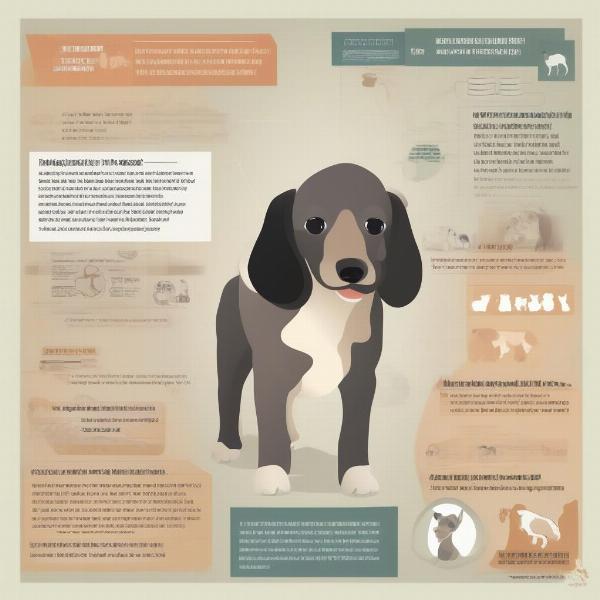A dog breeding chart is a valuable tool for responsible breeders. It helps track lineages, predict potential health issues, and maintain desirable traits. Whether you’re a seasoned breeder or just starting out, understanding how to use a dog breeding chart effectively is crucial for the well-being of future generations. This guide will delve into the different types of dog breeding charts, their benefits, and how to interpret them.
Types of Dog Breeding Charts and Their Uses
Several types of dog breeding charts cater to different breeding goals. The most common ones include:
Pedigree Charts
Pedigree charts, also known as family trees, trace a dog’s ancestry back several generations. They visually represent the lineage, highlighting ancestors and their relationships. This information is essential for identifying potential inherited traits, both positive and negative.
Linebreeding Charts
Linebreeding is a form of inbreeding where dogs with a common ancestor, but not closely related, are bred. dog line breeding chart help visualize these relationships, allowing breeders to maintain desirable traits while minimizing the risks associated with close inbreeding.
Inbreeding Charts
Inbreeding charts track the mating of closely related dogs, such as siblings or parent-offspring. While inbreeding can solidify desirable traits, it significantly increases the risk of inheriting genetic disorders. Therefore, careful planning and understanding of the potential consequences are crucial.
Punnett Squares
Punnett squares are used to predict the probability of offspring inheriting specific genes, including those related to coat color, size, and certain health conditions. While not strictly a breeding chart, they are valuable tools for breeders.
Interpreting a Dog Breeding Chart
Interpreting a dog breeding chart correctly is crucial for making informed breeding decisions. Here’s what to look for:
- Generations: Charts typically represent several generations, allowing breeders to track the inheritance of traits over time.
- Symbols: Different symbols represent males, females, and affected individuals. Understanding these symbols is essential for accurate interpretation.
- Lines of Descent: Lines connect individuals, showing direct parentage and relationships. Tracing these lines helps identify common ancestors and patterns of inheritance.
- Health Information: Some charts include information about health conditions, such as hip dysplasia or eye problems. This data is critical for assessing the risk of inherited diseases.
Benefits of Using Dog Breeding Charts
- Predicting Traits: Charts help predict the likelihood of offspring inheriting specific traits, allowing breeders to select for desirable characteristics.
- Managing Health Risks: By tracking lineages and health information, breeders can minimize the risk of passing on genetic disorders.
- Maintaining Breed Standards: Charts help breeders adhere to breed standards by ensuring the continuation of desired physical and temperamental traits.
- Informed Decision-Making: Breeding charts provide valuable data that empowers breeders to make informed decisions about mating pairs.
 Benefits of Using Dog Breeding Charts in Dog Breeding
Benefits of Using Dog Breeding Charts in Dog Breeding
Expert Insights
“A well-maintained dog breeding chart is a breeder’s best friend,” says Dr. Emily Carter, a renowned veterinary geneticist. “It provides a wealth of information about a dog’s lineage and health, enabling responsible breeding practices.”
“Understanding the information presented in a breeding chart is paramount,” adds canine behaviorist, Mark Johnson. “It allows breeders to select not only for physical traits but also for temperament and behavior.”
Conclusion
Dog breeding charts are indispensable tools for responsible breeders. They provide valuable insights into a dog’s lineage, health, and potential for passing on specific traits. By understanding how to use and interpret these charts, breeders can make informed decisions that promote the health and well-being of future generations. Utilizing a dog breeding chart is a testament to a breeder’s dedication to the betterment of their chosen breed.
FAQ
- What is the most common type of dog breeding chart? The most common type is the pedigree chart, which visually represents a dog’s family tree.
- How can I obtain a dog breeding chart? You can obtain a pedigree chart from kennel clubs, breeders, or online databases.
- Are dog breeding charts difficult to interpret? While they may seem complex at first, understanding the symbols and lines of descent becomes easier with practice.
- Can I create my own dog breeding chart? Yes, you can create your own chart using various software programs or even by hand.
- Why is it important to use a dog breeding chart? Using a chart promotes responsible breeding practices by helping breeders make informed decisions about mating pairs and minimizing the risk of inherited diseases.
- What is the difference between linebreeding and inbreeding? Linebreeding involves mating distantly related dogs with a common ancestor, while inbreeding involves mating close relatives.
- Where can I find more information about dog breeding charts? You can find more information from reputable breeders, canine organizations, and veterinary geneticists.
Related Articles on ILM Dog
ILM Dog is your trusted global resource for expert canine care and breeding guidance. From breed selection to health management, training, nutrition, grooming, and finding the perfect accessories, we offer comprehensive information and resources for dog owners worldwide. We specialize in providing insightful articles on topics like choosing the right breed, ensuring optimal health and medical care, mastering training techniques, understanding dog behavior, and providing the best nutrition and grooming practices. Explore our vast library of resources or contact us directly for personalized guidance. Email: [email protected], Phone: +44 20-3965-8624. ILM Dog is here to support you every step of the way on your dog ownership journey.